Ingogo: Marketing Strategies for Expanding Taxi Services in Australia
VerifiedAdded on 2023/06/07
|18
|3991
|184
AI Summary
This report analyzes the situational analysis, marketing strategies, and promotional tools for Ingogo, an Australian-based online taxi company. It includes SWOT analysis, customer and competitor analysis, segmentation, targeting, and positioning, and the 7 P's of marketing strategies. The report also discusses the company's financial and marketing objectives and budget allocation for promotion mix.
Contribute Materials
Your contribution can guide someone’s learning journey. Share your
documents today.
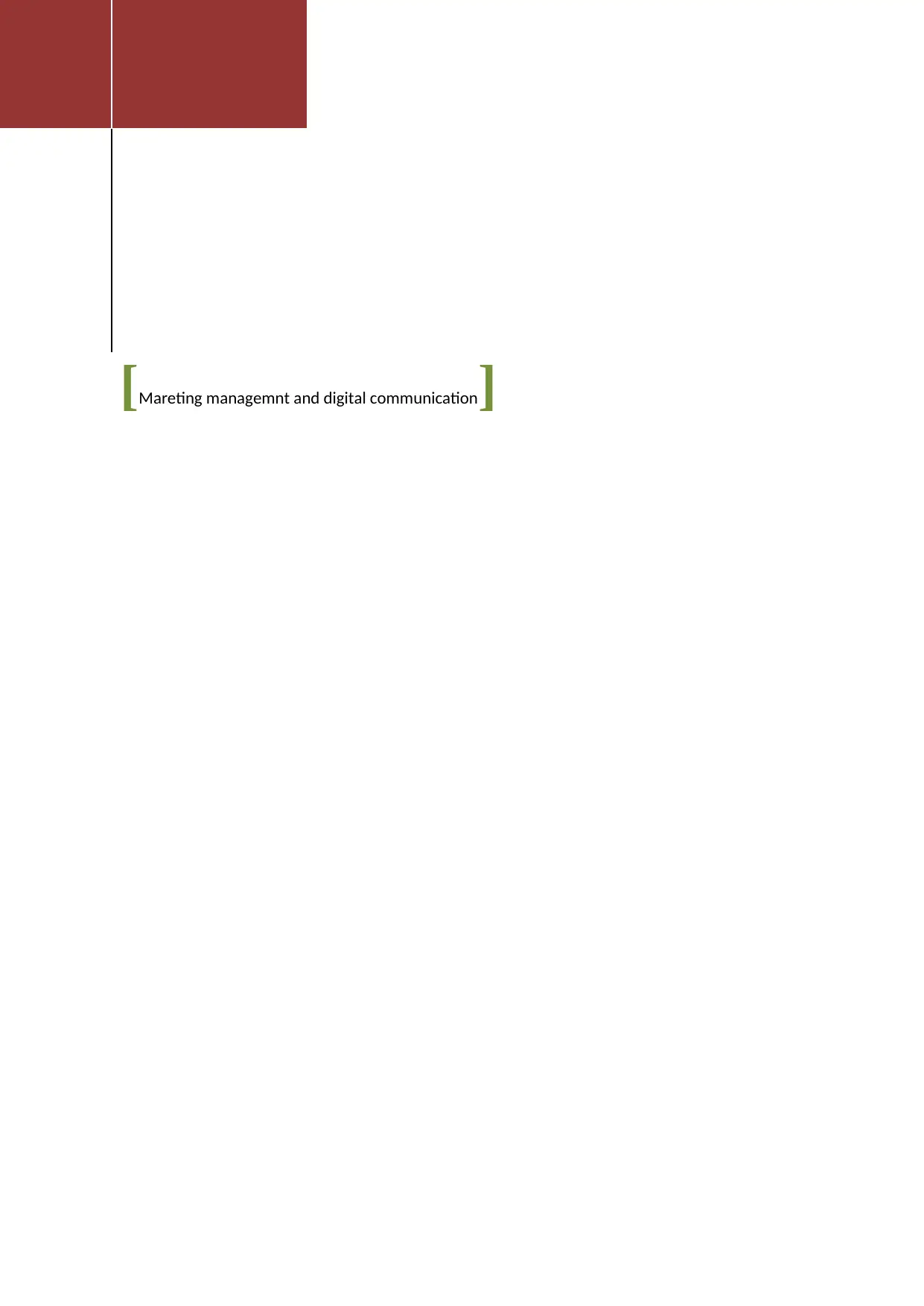
[Mareting managemnt and digital communication]
Secure Best Marks with AI Grader
Need help grading? Try our AI Grader for instant feedback on your assignments.
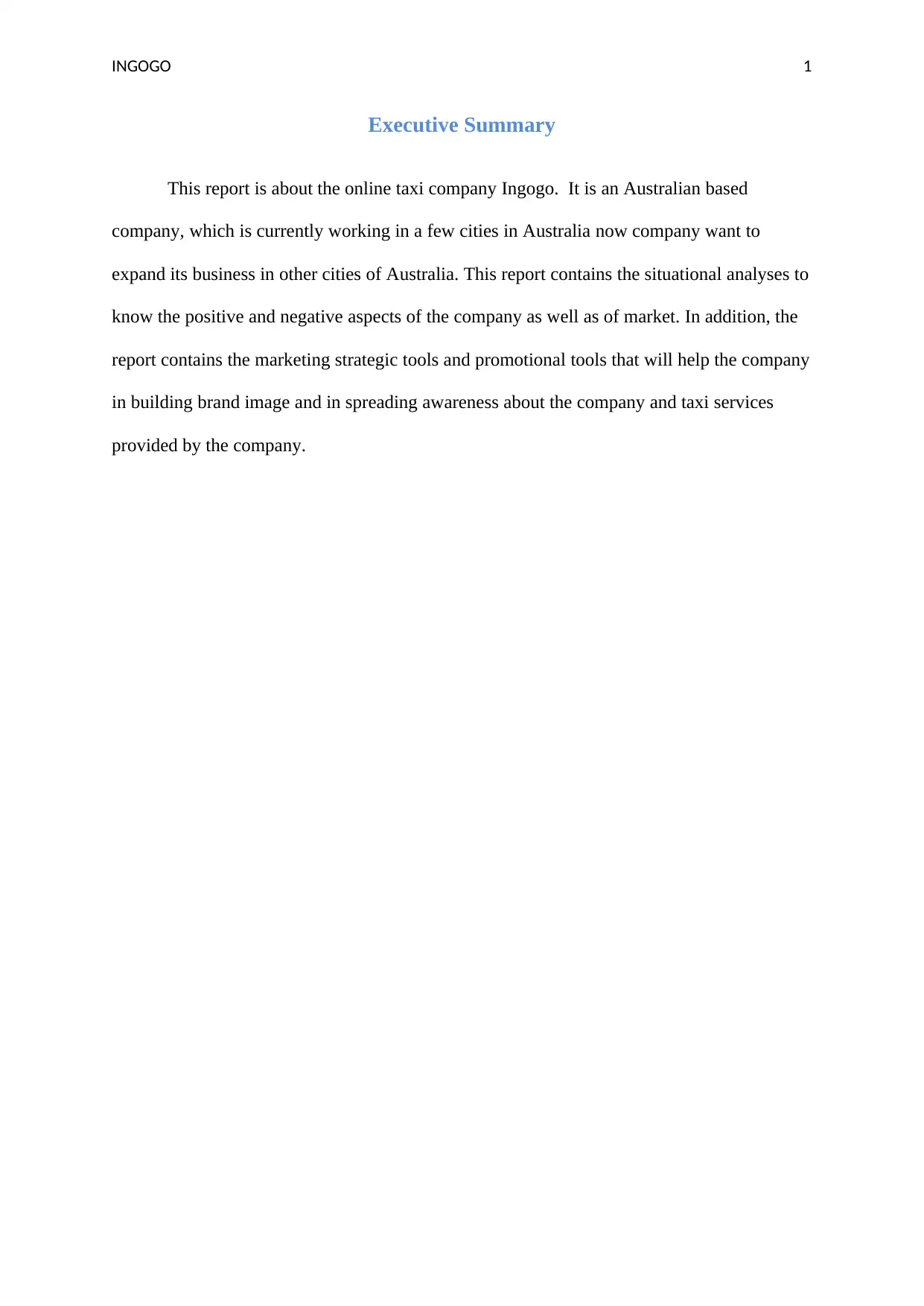
INGOGO 1
Executive Summary
This report is about the online taxi company Ingogo. It is an Australian based
company, which is currently working in a few cities in Australia now company want to
expand its business in other cities of Australia. This report contains the situational analyses to
know the positive and negative aspects of the company as well as of market. In addition, the
report contains the marketing strategic tools and promotional tools that will help the company
in building brand image and in spreading awareness about the company and taxi services
provided by the company.
Executive Summary
This report is about the online taxi company Ingogo. It is an Australian based
company, which is currently working in a few cities in Australia now company want to
expand its business in other cities of Australia. This report contains the situational analyses to
know the positive and negative aspects of the company as well as of market. In addition, the
report contains the marketing strategic tools and promotional tools that will help the company
in building brand image and in spreading awareness about the company and taxi services
provided by the company.
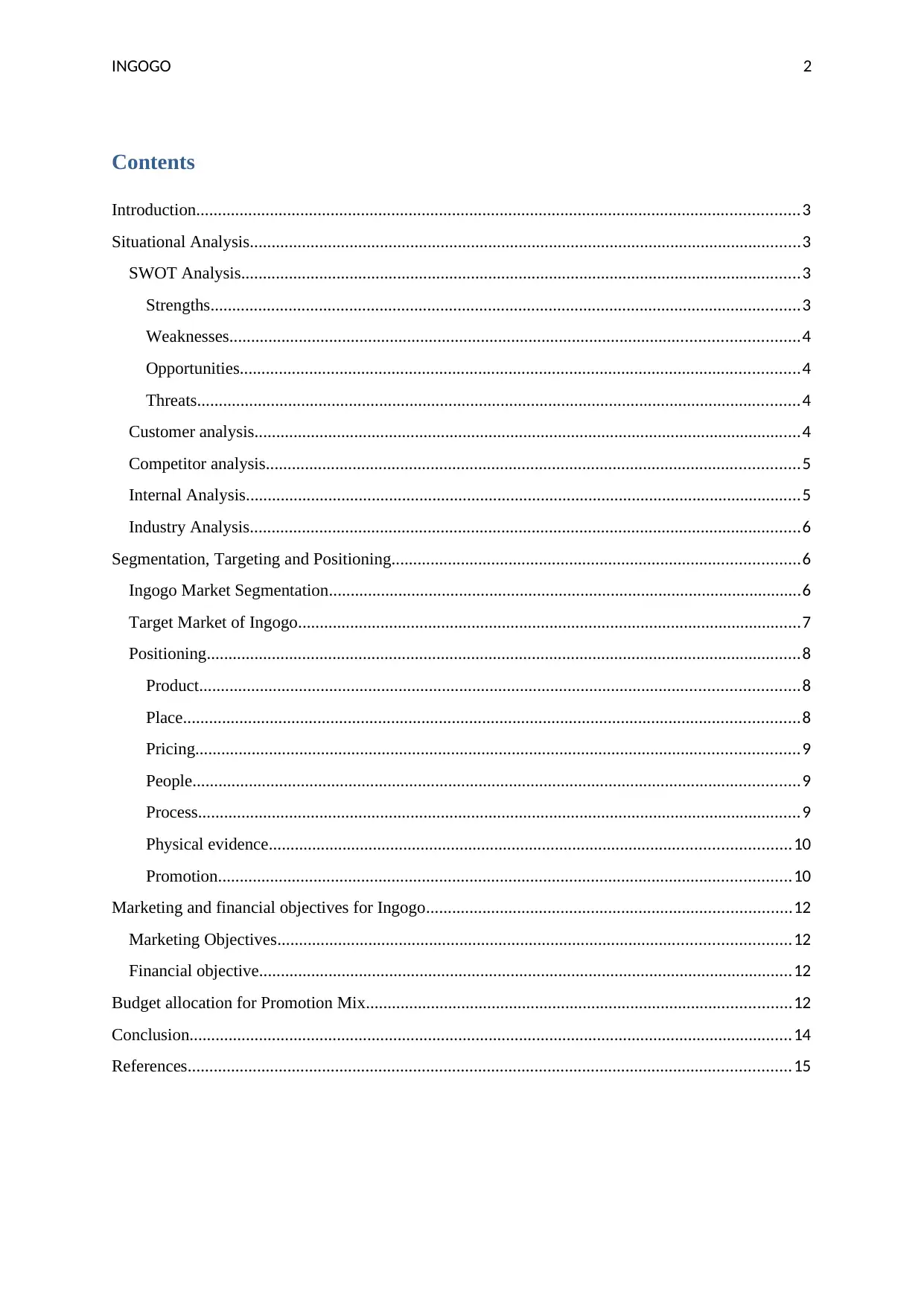
INGOGO 2
Contents
Introduction...........................................................................................................................................3
Situational Analysis...............................................................................................................................3
SWOT Analysis.................................................................................................................................3
Strengths........................................................................................................................................3
Weaknesses...................................................................................................................................4
Opportunities.................................................................................................................................4
Threats...........................................................................................................................................4
Customer analysis..............................................................................................................................4
Competitor analysis...........................................................................................................................5
Internal Analysis................................................................................................................................5
Industry Analysis...............................................................................................................................6
Segmentation, Targeting and Positioning..............................................................................................6
Ingogo Market Segmentation.............................................................................................................6
Target Market of Ingogo....................................................................................................................7
Positioning.........................................................................................................................................8
Product..........................................................................................................................................8
Place..............................................................................................................................................8
Pricing...........................................................................................................................................9
People............................................................................................................................................9
Process...........................................................................................................................................9
Physical evidence........................................................................................................................10
Promotion....................................................................................................................................10
Marketing and financial objectives for Ingogo....................................................................................12
Marketing Objectives......................................................................................................................12
Financial objective...........................................................................................................................12
Budget allocation for Promotion Mix..................................................................................................12
Conclusion...........................................................................................................................................14
References...........................................................................................................................................15
Contents
Introduction...........................................................................................................................................3
Situational Analysis...............................................................................................................................3
SWOT Analysis.................................................................................................................................3
Strengths........................................................................................................................................3
Weaknesses...................................................................................................................................4
Opportunities.................................................................................................................................4
Threats...........................................................................................................................................4
Customer analysis..............................................................................................................................4
Competitor analysis...........................................................................................................................5
Internal Analysis................................................................................................................................5
Industry Analysis...............................................................................................................................6
Segmentation, Targeting and Positioning..............................................................................................6
Ingogo Market Segmentation.............................................................................................................6
Target Market of Ingogo....................................................................................................................7
Positioning.........................................................................................................................................8
Product..........................................................................................................................................8
Place..............................................................................................................................................8
Pricing...........................................................................................................................................9
People............................................................................................................................................9
Process...........................................................................................................................................9
Physical evidence........................................................................................................................10
Promotion....................................................................................................................................10
Marketing and financial objectives for Ingogo....................................................................................12
Marketing Objectives......................................................................................................................12
Financial objective...........................................................................................................................12
Budget allocation for Promotion Mix..................................................................................................12
Conclusion...........................................................................................................................................14
References...........................................................................................................................................15
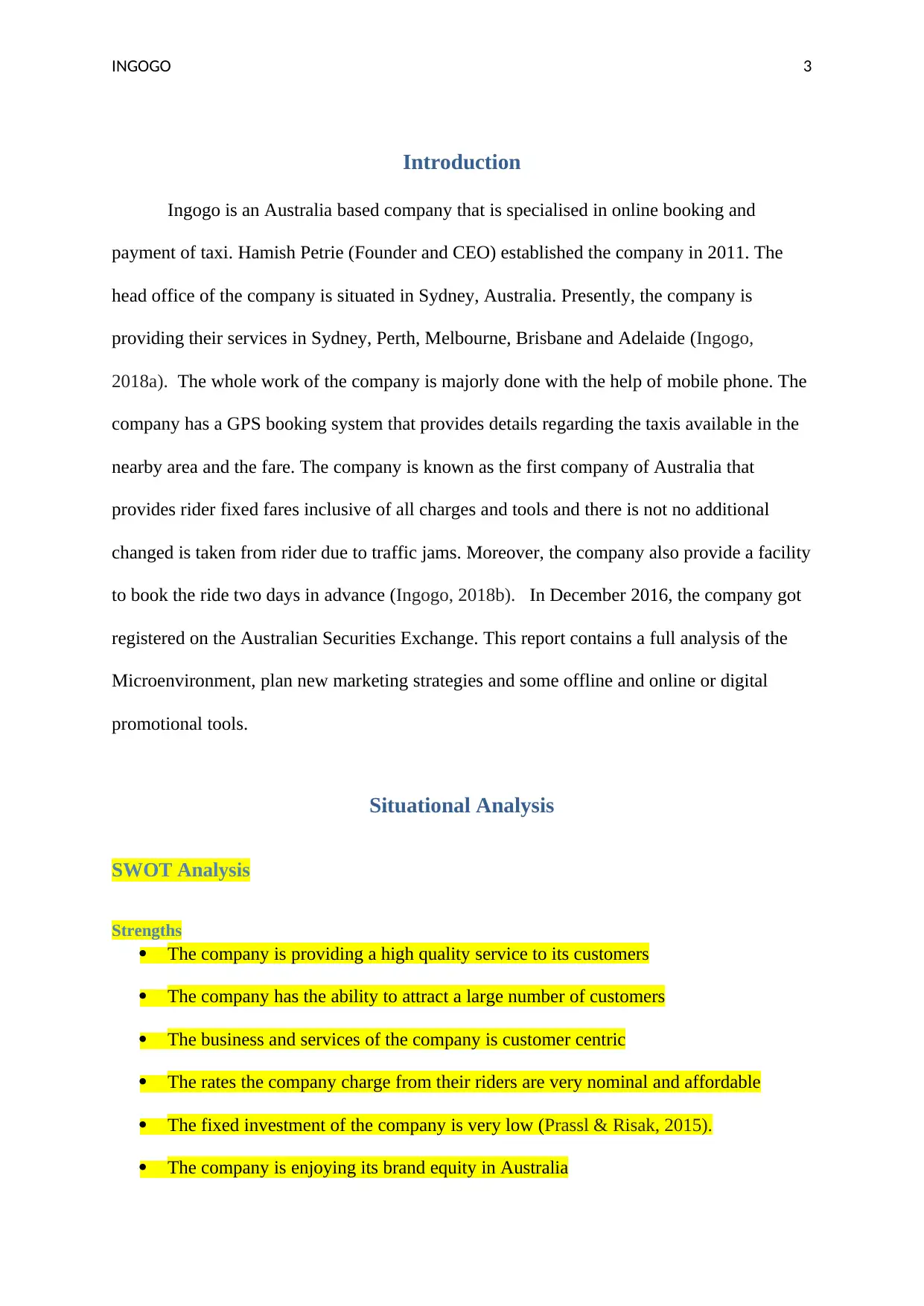
INGOGO 3
Introduction
Ingogo is an Australia based company that is specialised in online booking and
payment of taxi. Hamish Petrie (Founder and CEO) established the company in 2011. The
head office of the company is situated in Sydney, Australia. Presently, the company is
providing their services in Sydney, Perth, Melbourne, Brisbane and Adelaide (Ingogo,
2018a). The whole work of the company is majorly done with the help of mobile phone. The
company has a GPS booking system that provides details regarding the taxis available in the
nearby area and the fare. The company is known as the first company of Australia that
provides rider fixed fares inclusive of all charges and tools and there is not no additional
changed is taken from rider due to traffic jams. Moreover, the company also provide a facility
to book the ride two days in advance (Ingogo, 2018b). In December 2016, the company got
registered on the Australian Securities Exchange. This report contains a full analysis of the
Microenvironment, plan new marketing strategies and some offline and online or digital
promotional tools.
Situational Analysis
SWOT Analysis
Strengths
The company is providing a high quality service to its customers
The company has the ability to attract a large number of customers
The business and services of the company is customer centric
The rates the company charge from their riders are very nominal and affordable
The fixed investment of the company is very low (Prassl & Risak, 2015).
The company is enjoying its brand equity in Australia
Introduction
Ingogo is an Australia based company that is specialised in online booking and
payment of taxi. Hamish Petrie (Founder and CEO) established the company in 2011. The
head office of the company is situated in Sydney, Australia. Presently, the company is
providing their services in Sydney, Perth, Melbourne, Brisbane and Adelaide (Ingogo,
2018a). The whole work of the company is majorly done with the help of mobile phone. The
company has a GPS booking system that provides details regarding the taxis available in the
nearby area and the fare. The company is known as the first company of Australia that
provides rider fixed fares inclusive of all charges and tools and there is not no additional
changed is taken from rider due to traffic jams. Moreover, the company also provide a facility
to book the ride two days in advance (Ingogo, 2018b). In December 2016, the company got
registered on the Australian Securities Exchange. This report contains a full analysis of the
Microenvironment, plan new marketing strategies and some offline and online or digital
promotional tools.
Situational Analysis
SWOT Analysis
Strengths
The company is providing a high quality service to its customers
The company has the ability to attract a large number of customers
The business and services of the company is customer centric
The rates the company charge from their riders are very nominal and affordable
The fixed investment of the company is very low (Prassl & Risak, 2015).
The company is enjoying its brand equity in Australia
Secure Best Marks with AI Grader
Need help grading? Try our AI Grader for instant feedback on your assignments.

INGOGO 4
The business of company provide its focus on customer satisfaction
Weaknesses
the business of the company is highly depend on the manpower
the business of the company is fully depend on the internet service
the business lack in providing facilities like safety measure and sharing
the increased prices of gas and petrol reduce the profit share of the company (Gao &
Low, 2014)
Opportunities
the company can add new additional technologies in the business
to enhance the business of the company they can add bus rides for long routes
the company can incorporate improvement in service delivery
the company can increase internet penetration
the company can take advantage of dissatisfaction among customers due to
unorganised market (Pavelsky et.al. 2014)
Threats
the increasing competition in the Australia market in the same industry
the competitors of the company are incorporation new and innovative ideas in their
business
with the existing competitors the threat of new entrance also available
The government regulations related to taxi industry are unclear (Dobbs, 2014).
Customer analysis
At present, the company is having the total market size of around two million
passengers and these figures of passengers are increasing continuously every year. In the
market, the company is targeting almost every section of society who is using smartphones or
has the knowledge of using the mobile application except children (Fertel, Bahn, Vaillancourt
The business of company provide its focus on customer satisfaction
Weaknesses
the business of the company is highly depend on the manpower
the business of the company is fully depend on the internet service
the business lack in providing facilities like safety measure and sharing
the increased prices of gas and petrol reduce the profit share of the company (Gao &
Low, 2014)
Opportunities
the company can add new additional technologies in the business
to enhance the business of the company they can add bus rides for long routes
the company can incorporate improvement in service delivery
the company can increase internet penetration
the company can take advantage of dissatisfaction among customers due to
unorganised market (Pavelsky et.al. 2014)
Threats
the increasing competition in the Australia market in the same industry
the competitors of the company are incorporation new and innovative ideas in their
business
with the existing competitors the threat of new entrance also available
The government regulations related to taxi industry are unclear (Dobbs, 2014).
Customer analysis
At present, the company is having the total market size of around two million
passengers and these figures of passengers are increasing continuously every year. In the
market, the company is targeting almost every section of society who is using smartphones or
has the knowledge of using the mobile application except children (Fertel, Bahn, Vaillancourt
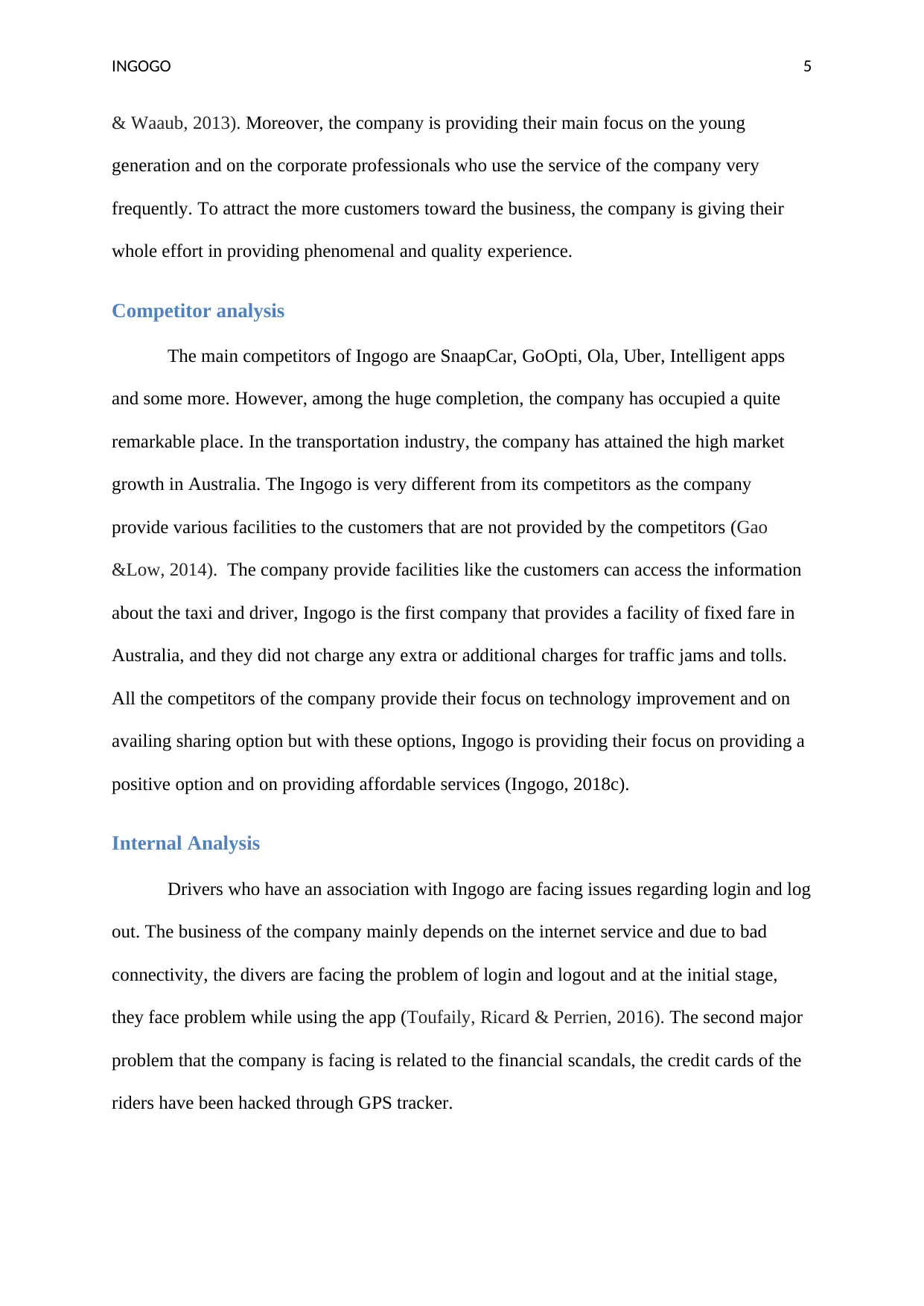
INGOGO 5
& Waaub, 2013). Moreover, the company is providing their main focus on the young
generation and on the corporate professionals who use the service of the company very
frequently. To attract the more customers toward the business, the company is giving their
whole effort in providing phenomenal and quality experience.
Competitor analysis
The main competitors of Ingogo are SnaapCar, GoOpti, Ola, Uber, Intelligent apps
and some more. However, among the huge completion, the company has occupied a quite
remarkable place. In the transportation industry, the company has attained the high market
growth in Australia. The Ingogo is very different from its competitors as the company
provide various facilities to the customers that are not provided by the competitors (Gao
&Low, 2014). The company provide facilities like the customers can access the information
about the taxi and driver, Ingogo is the first company that provides a facility of fixed fare in
Australia, and they did not charge any extra or additional charges for traffic jams and tolls.
All the competitors of the company provide their focus on technology improvement and on
availing sharing option but with these options, Ingogo is providing their focus on providing a
positive option and on providing affordable services (Ingogo, 2018c).
Internal Analysis
Drivers who have an association with Ingogo are facing issues regarding login and log
out. The business of the company mainly depends on the internet service and due to bad
connectivity, the divers are facing the problem of login and logout and at the initial stage,
they face problem while using the app (Toufaily, Ricard & Perrien, 2016). The second major
problem that the company is facing is related to the financial scandals, the credit cards of the
riders have been hacked through GPS tracker.
& Waaub, 2013). Moreover, the company is providing their main focus on the young
generation and on the corporate professionals who use the service of the company very
frequently. To attract the more customers toward the business, the company is giving their
whole effort in providing phenomenal and quality experience.
Competitor analysis
The main competitors of Ingogo are SnaapCar, GoOpti, Ola, Uber, Intelligent apps
and some more. However, among the huge completion, the company has occupied a quite
remarkable place. In the transportation industry, the company has attained the high market
growth in Australia. The Ingogo is very different from its competitors as the company
provide various facilities to the customers that are not provided by the competitors (Gao
&Low, 2014). The company provide facilities like the customers can access the information
about the taxi and driver, Ingogo is the first company that provides a facility of fixed fare in
Australia, and they did not charge any extra or additional charges for traffic jams and tolls.
All the competitors of the company provide their focus on technology improvement and on
availing sharing option but with these options, Ingogo is providing their focus on providing a
positive option and on providing affordable services (Ingogo, 2018c).
Internal Analysis
Drivers who have an association with Ingogo are facing issues regarding login and log
out. The business of the company mainly depends on the internet service and due to bad
connectivity, the divers are facing the problem of login and logout and at the initial stage,
they face problem while using the app (Toufaily, Ricard & Perrien, 2016). The second major
problem that the company is facing is related to the financial scandals, the credit cards of the
riders have been hacked through GPS tracker.
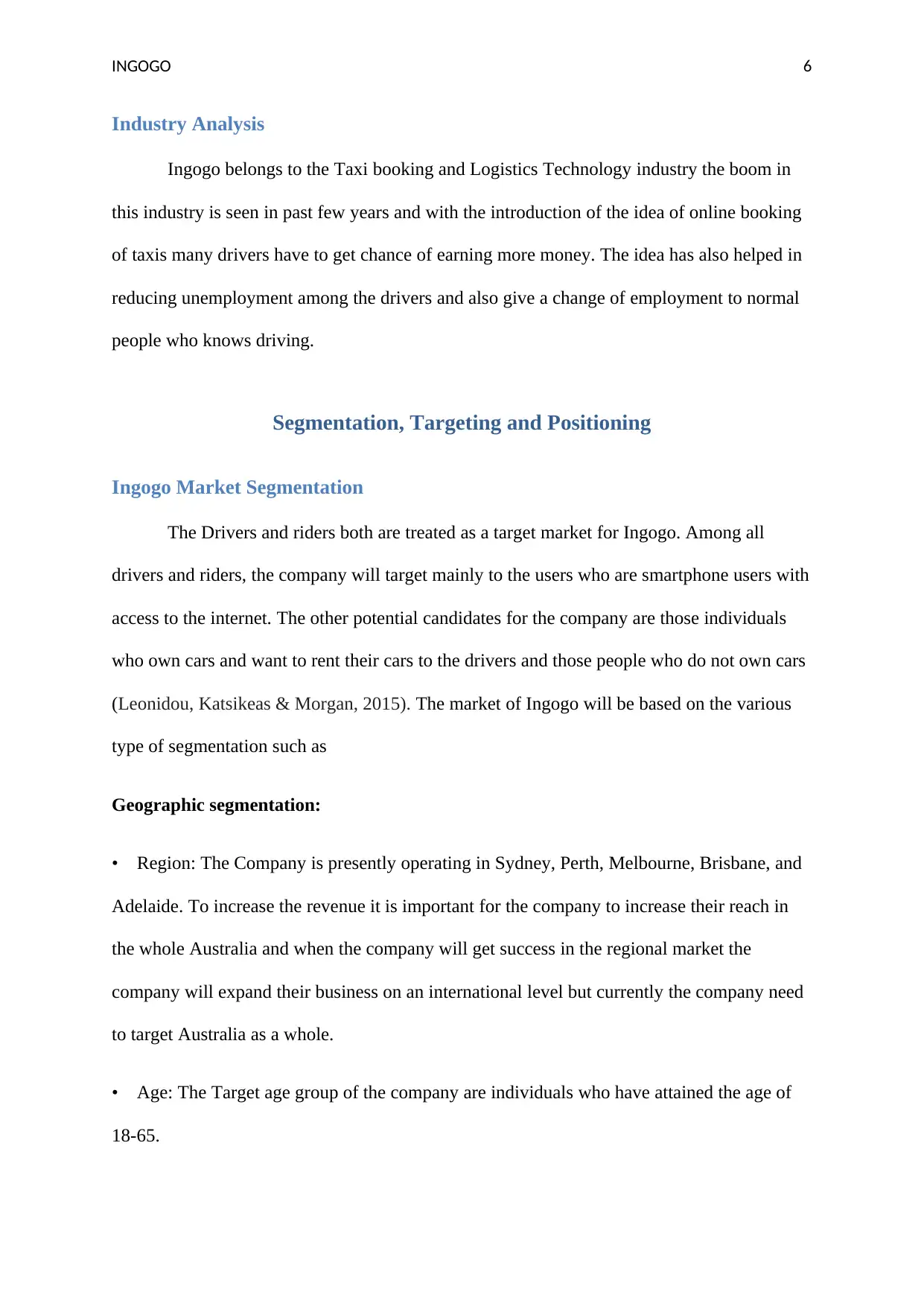
INGOGO 6
Industry Analysis
Ingogo belongs to the Taxi booking and Logistics Technology industry the boom in
this industry is seen in past few years and with the introduction of the idea of online booking
of taxis many drivers have to get chance of earning more money. The idea has also helped in
reducing unemployment among the drivers and also give a change of employment to normal
people who knows driving.
Segmentation, Targeting and Positioning
Ingogo Market Segmentation
The Drivers and riders both are treated as a target market for Ingogo. Among all
drivers and riders, the company will target mainly to the users who are smartphone users with
access to the internet. The other potential candidates for the company are those individuals
who own cars and want to rent their cars to the drivers and those people who do not own cars
(Leonidou, Katsikeas & Morgan, 2015). The market of Ingogo will be based on the various
type of segmentation such as
Geographic segmentation:
• Region: The Company is presently operating in Sydney, Perth, Melbourne, Brisbane, and
Adelaide. To increase the revenue it is important for the company to increase their reach in
the whole Australia and when the company will get success in the regional market the
company will expand their business on an international level but currently the company need
to target Australia as a whole.
• Age: The Target age group of the company are individuals who have attained the age of
18-65.
Industry Analysis
Ingogo belongs to the Taxi booking and Logistics Technology industry the boom in
this industry is seen in past few years and with the introduction of the idea of online booking
of taxis many drivers have to get chance of earning more money. The idea has also helped in
reducing unemployment among the drivers and also give a change of employment to normal
people who knows driving.
Segmentation, Targeting and Positioning
Ingogo Market Segmentation
The Drivers and riders both are treated as a target market for Ingogo. Among all
drivers and riders, the company will target mainly to the users who are smartphone users with
access to the internet. The other potential candidates for the company are those individuals
who own cars and want to rent their cars to the drivers and those people who do not own cars
(Leonidou, Katsikeas & Morgan, 2015). The market of Ingogo will be based on the various
type of segmentation such as
Geographic segmentation:
• Region: The Company is presently operating in Sydney, Perth, Melbourne, Brisbane, and
Adelaide. To increase the revenue it is important for the company to increase their reach in
the whole Australia and when the company will get success in the regional market the
company will expand their business on an international level but currently the company need
to target Australia as a whole.
• Age: The Target age group of the company are individuals who have attained the age of
18-65.
Paraphrase This Document
Need a fresh take? Get an instant paraphrase of this document with our AI Paraphraser
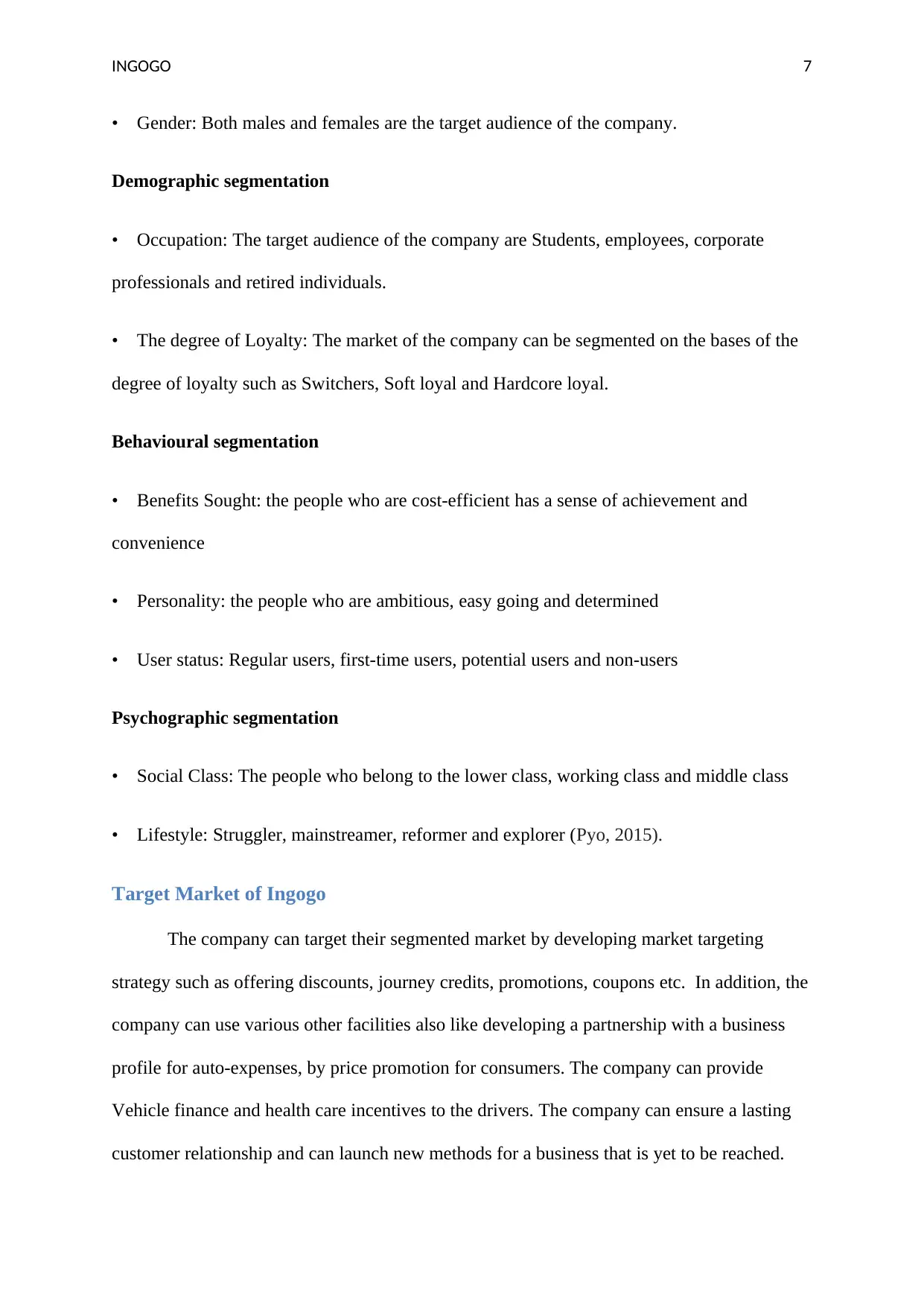
INGOGO 7
• Gender: Both males and females are the target audience of the company.
Demographic segmentation
• Occupation: The target audience of the company are Students, employees, corporate
professionals and retired individuals.
• The degree of Loyalty: The market of the company can be segmented on the bases of the
degree of loyalty such as Switchers, Soft loyal and Hardcore loyal.
Behavioural segmentation
• Benefits Sought: the people who are cost-efficient has a sense of achievement and
convenience
• Personality: the people who are ambitious, easy going and determined
• User status: Regular users, first-time users, potential users and non-users
Psychographic segmentation
• Social Class: The people who belong to the lower class, working class and middle class
• Lifestyle: Struggler, mainstreamer, reformer and explorer (Pyo, 2015).
Target Market of Ingogo
The company can target their segmented market by developing market targeting
strategy such as offering discounts, journey credits, promotions, coupons etc. In addition, the
company can use various other facilities also like developing a partnership with a business
profile for auto-expenses, by price promotion for consumers. The company can provide
Vehicle finance and health care incentives to the drivers. The company can ensure a lasting
customer relationship and can launch new methods for a business that is yet to be reached.
• Gender: Both males and females are the target audience of the company.
Demographic segmentation
• Occupation: The target audience of the company are Students, employees, corporate
professionals and retired individuals.
• The degree of Loyalty: The market of the company can be segmented on the bases of the
degree of loyalty such as Switchers, Soft loyal and Hardcore loyal.
Behavioural segmentation
• Benefits Sought: the people who are cost-efficient has a sense of achievement and
convenience
• Personality: the people who are ambitious, easy going and determined
• User status: Regular users, first-time users, potential users and non-users
Psychographic segmentation
• Social Class: The people who belong to the lower class, working class and middle class
• Lifestyle: Struggler, mainstreamer, reformer and explorer (Pyo, 2015).
Target Market of Ingogo
The company can target their segmented market by developing market targeting
strategy such as offering discounts, journey credits, promotions, coupons etc. In addition, the
company can use various other facilities also like developing a partnership with a business
profile for auto-expenses, by price promotion for consumers. The company can provide
Vehicle finance and health care incentives to the drivers. The company can ensure a lasting
customer relationship and can launch new methods for a business that is yet to be reached.
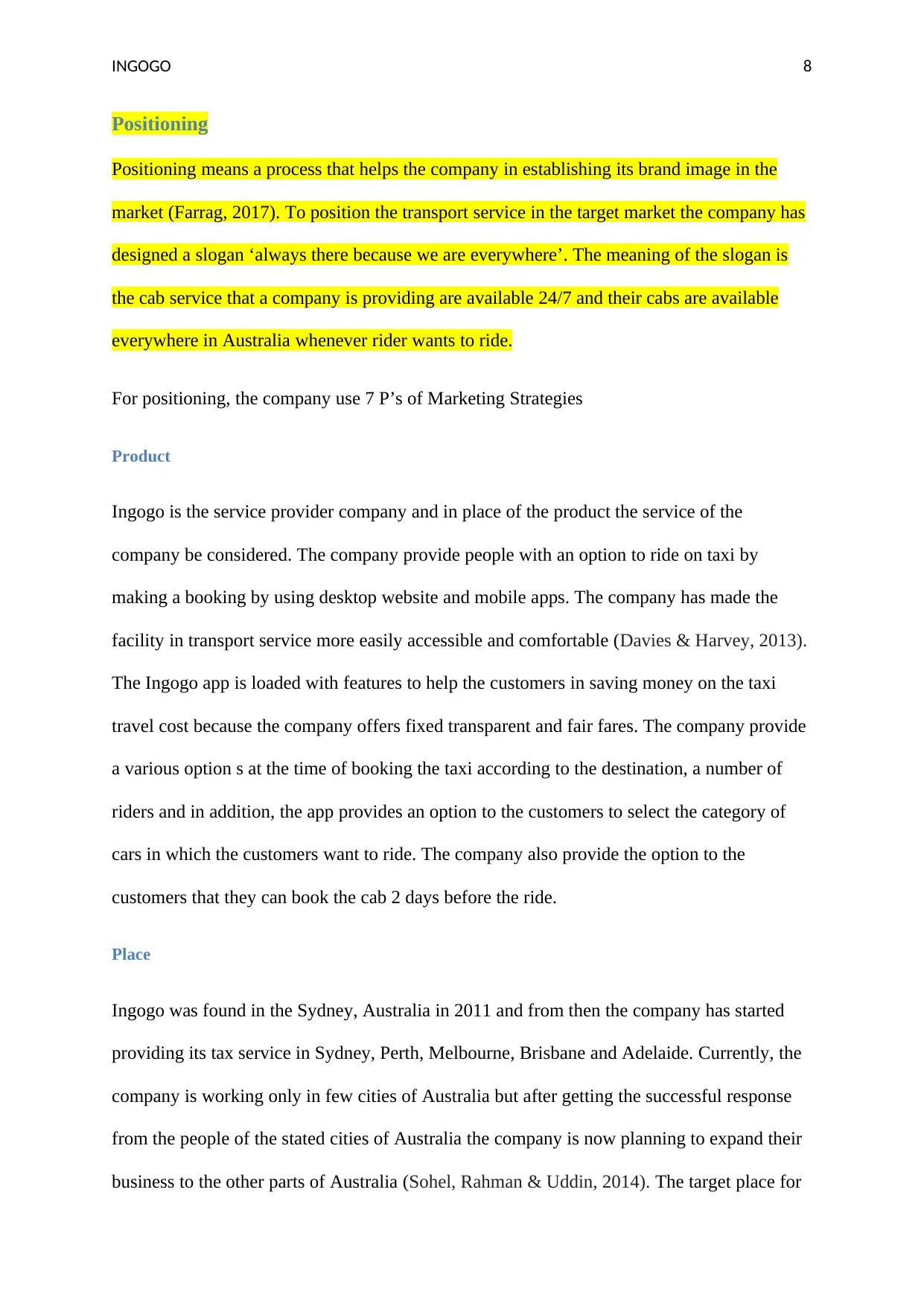
INGOGO 8
Positioning
Positioning means a process that helps the company in establishing its brand image in the
market (Farrag, 2017). To position the transport service in the target market the company has
designed a slogan ‘always there because we are everywhere’. The meaning of the slogan is
the cab service that a company is providing are available 24/7 and their cabs are available
everywhere in Australia whenever rider wants to ride.
For positioning, the company use 7 P’s of Marketing Strategies
Product
Ingogo is the service provider company and in place of the product the service of the
company be considered. The company provide people with an option to ride on taxi by
making a booking by using desktop website and mobile apps. The company has made the
facility in transport service more easily accessible and comfortable (Davies & Harvey, 2013).
The Ingogo app is loaded with features to help the customers in saving money on the taxi
travel cost because the company offers fixed transparent and fair fares. The company provide
a various option s at the time of booking the taxi according to the destination, a number of
riders and in addition, the app provides an option to the customers to select the category of
cars in which the customers want to ride. The company also provide the option to the
customers that they can book the cab 2 days before the ride.
Place
Ingogo was found in the Sydney, Australia in 2011 and from then the company has started
providing its tax service in Sydney, Perth, Melbourne, Brisbane and Adelaide. Currently, the
company is working only in few cities of Australia but after getting the successful response
from the people of the stated cities of Australia the company is now planning to expand their
business to the other parts of Australia (Sohel, Rahman & Uddin, 2014). The target place for
Positioning
Positioning means a process that helps the company in establishing its brand image in the
market (Farrag, 2017). To position the transport service in the target market the company has
designed a slogan ‘always there because we are everywhere’. The meaning of the slogan is
the cab service that a company is providing are available 24/7 and their cabs are available
everywhere in Australia whenever rider wants to ride.
For positioning, the company use 7 P’s of Marketing Strategies
Product
Ingogo is the service provider company and in place of the product the service of the
company be considered. The company provide people with an option to ride on taxi by
making a booking by using desktop website and mobile apps. The company has made the
facility in transport service more easily accessible and comfortable (Davies & Harvey, 2013).
The Ingogo app is loaded with features to help the customers in saving money on the taxi
travel cost because the company offers fixed transparent and fair fares. The company provide
a various option s at the time of booking the taxi according to the destination, a number of
riders and in addition, the app provides an option to the customers to select the category of
cars in which the customers want to ride. The company also provide the option to the
customers that they can book the cab 2 days before the ride.
Place
Ingogo was found in the Sydney, Australia in 2011 and from then the company has started
providing its tax service in Sydney, Perth, Melbourne, Brisbane and Adelaide. Currently, the
company is working only in few cities of Australia but after getting the successful response
from the people of the stated cities of Australia the company is now planning to expand their
business to the other parts of Australia (Sohel, Rahman & Uddin, 2014). The target place for
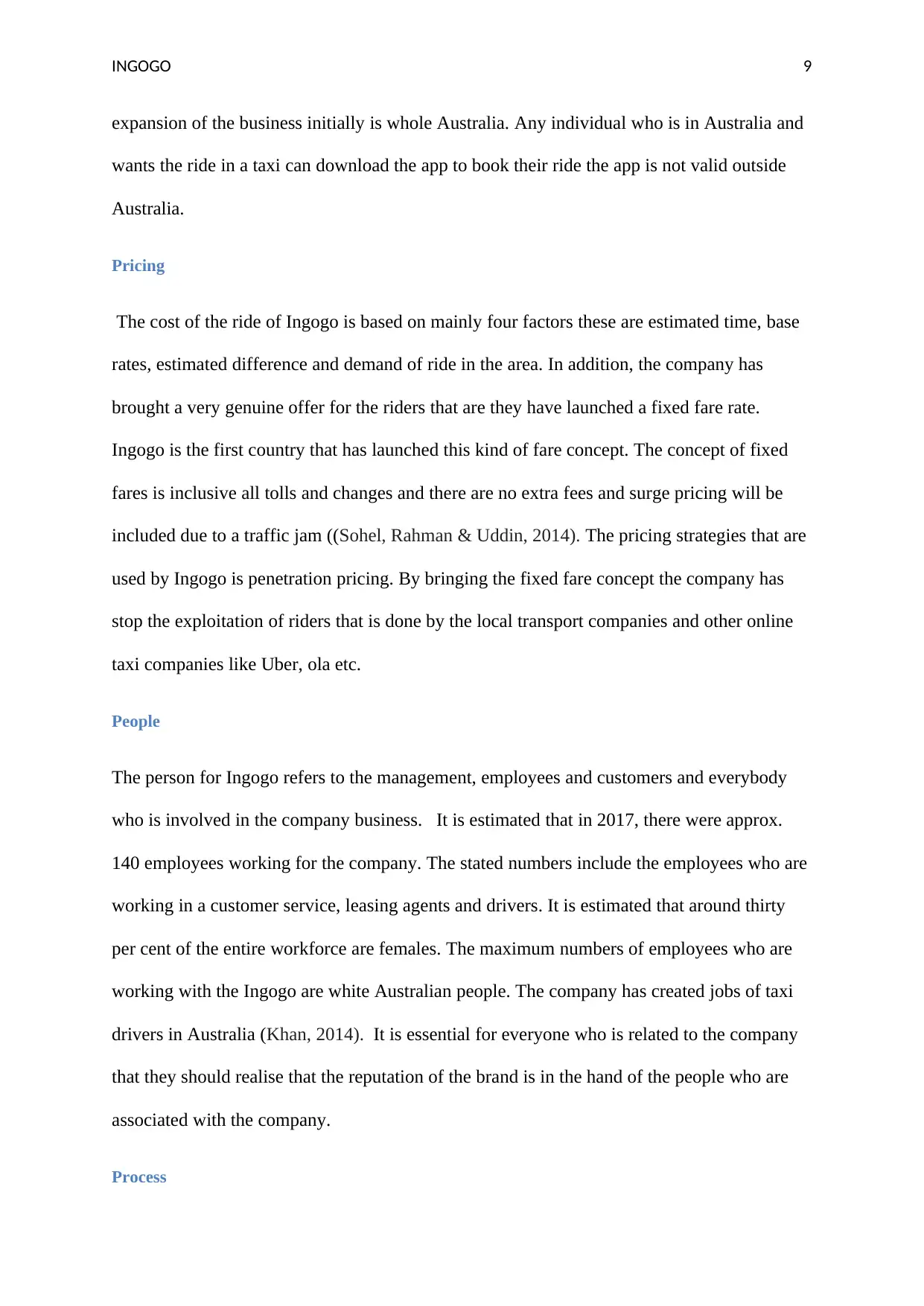
INGOGO 9
expansion of the business initially is whole Australia. Any individual who is in Australia and
wants the ride in a taxi can download the app to book their ride the app is not valid outside
Australia.
Pricing
The cost of the ride of Ingogo is based on mainly four factors these are estimated time, base
rates, estimated difference and demand of ride in the area. In addition, the company has
brought a very genuine offer for the riders that are they have launched a fixed fare rate.
Ingogo is the first country that has launched this kind of fare concept. The concept of fixed
fares is inclusive all tolls and changes and there are no extra fees and surge pricing will be
included due to a traffic jam ((Sohel, Rahman & Uddin, 2014). The pricing strategies that are
used by Ingogo is penetration pricing. By bringing the fixed fare concept the company has
stop the exploitation of riders that is done by the local transport companies and other online
taxi companies like Uber, ola etc.
People
The person for Ingogo refers to the management, employees and customers and everybody
who is involved in the company business. It is estimated that in 2017, there were approx.
140 employees working for the company. The stated numbers include the employees who are
working in a customer service, leasing agents and drivers. It is estimated that around thirty
per cent of the entire workforce are females. The maximum numbers of employees who are
working with the Ingogo are white Australian people. The company has created jobs of taxi
drivers in Australia (Khan, 2014). It is essential for everyone who is related to the company
that they should realise that the reputation of the brand is in the hand of the people who are
associated with the company.
Process
expansion of the business initially is whole Australia. Any individual who is in Australia and
wants the ride in a taxi can download the app to book their ride the app is not valid outside
Australia.
Pricing
The cost of the ride of Ingogo is based on mainly four factors these are estimated time, base
rates, estimated difference and demand of ride in the area. In addition, the company has
brought a very genuine offer for the riders that are they have launched a fixed fare rate.
Ingogo is the first country that has launched this kind of fare concept. The concept of fixed
fares is inclusive all tolls and changes and there are no extra fees and surge pricing will be
included due to a traffic jam ((Sohel, Rahman & Uddin, 2014). The pricing strategies that are
used by Ingogo is penetration pricing. By bringing the fixed fare concept the company has
stop the exploitation of riders that is done by the local transport companies and other online
taxi companies like Uber, ola etc.
People
The person for Ingogo refers to the management, employees and customers and everybody
who is involved in the company business. It is estimated that in 2017, there were approx.
140 employees working for the company. The stated numbers include the employees who are
working in a customer service, leasing agents and drivers. It is estimated that around thirty
per cent of the entire workforce are females. The maximum numbers of employees who are
working with the Ingogo are white Australian people. The company has created jobs of taxi
drivers in Australia (Khan, 2014). It is essential for everyone who is related to the company
that they should realise that the reputation of the brand is in the hand of the people who are
associated with the company.
Process
Secure Best Marks with AI Grader
Need help grading? Try our AI Grader for instant feedback on your assignments.

INGOGO 10
The process of the company include, the working of the company is completely dependent on
the mobile and desktop application. The customers who want to hire a taxi for a ride first they
have to install an app from the app store then they have to register on the app by providing
some necessary details. After registration, the rider can use the app any time they just need to
input information related to pick and drop location, the app will show the customer all
available taxis in the nearby area. The rider can select the taxi of their choice to take a ride
and after reaching to the desired location app will tell the estimated bill. The drivers also have
an app that is different from the consumer's app.
Physical evidence
The company is having its registered office in Sydney, Australia. Company’s most of the
business is carried out through website and app. Both customers and drivers have different
apps as per their wants. Apart from these, the only Physical evidence of the company is its
service, taxies and taxi drivers (Pike & Page, 2014). Sometimes the new paper article for
promotion, brochures and pamphlets also considered as physical evidence.
Promotion
Ingogo mainly uses its app and website for promotion. Moreover, the company has created
various buzz through its differentiated service which has generated a lot of publicity. Few
promotional tools used by Ingogo are:
Offline Marketing
Banners and posters: the company can design some eye-catching poster and banners and
can put them on areas that catch the attraction of people such as markets, bus stands etc. it
can help the company in attracting new customers.
The process of the company include, the working of the company is completely dependent on
the mobile and desktop application. The customers who want to hire a taxi for a ride first they
have to install an app from the app store then they have to register on the app by providing
some necessary details. After registration, the rider can use the app any time they just need to
input information related to pick and drop location, the app will show the customer all
available taxis in the nearby area. The rider can select the taxi of their choice to take a ride
and after reaching to the desired location app will tell the estimated bill. The drivers also have
an app that is different from the consumer's app.
Physical evidence
The company is having its registered office in Sydney, Australia. Company’s most of the
business is carried out through website and app. Both customers and drivers have different
apps as per their wants. Apart from these, the only Physical evidence of the company is its
service, taxies and taxi drivers (Pike & Page, 2014). Sometimes the new paper article for
promotion, brochures and pamphlets also considered as physical evidence.
Promotion
Ingogo mainly uses its app and website for promotion. Moreover, the company has created
various buzz through its differentiated service which has generated a lot of publicity. Few
promotional tools used by Ingogo are:
Offline Marketing
Banners and posters: the company can design some eye-catching poster and banners and
can put them on areas that catch the attraction of people such as markets, bus stands etc. it
can help the company in attracting new customers.
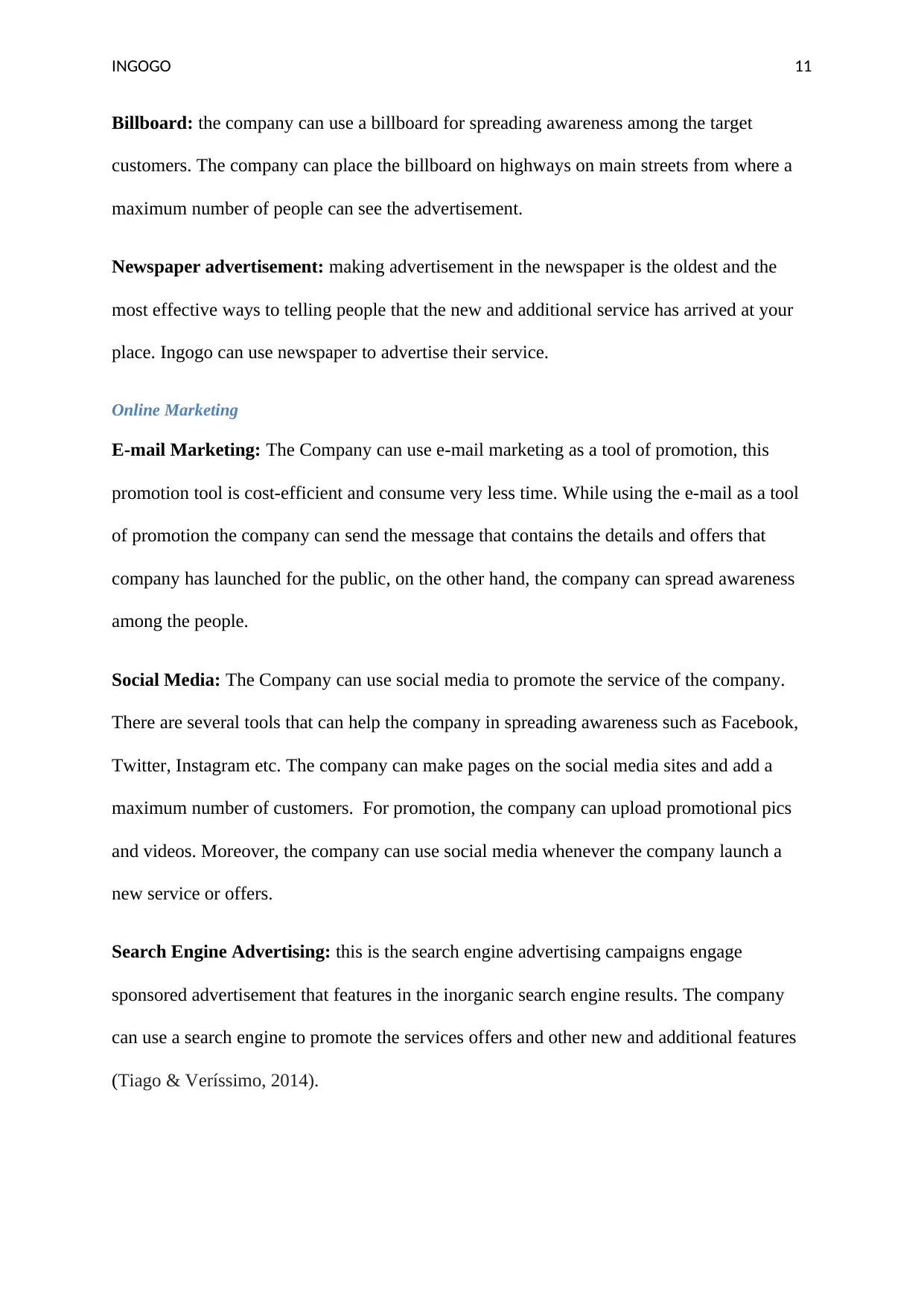
INGOGO 11
Billboard: the company can use a billboard for spreading awareness among the target
customers. The company can place the billboard on highways on main streets from where a
maximum number of people can see the advertisement.
Newspaper advertisement: making advertisement in the newspaper is the oldest and the
most effective ways to telling people that the new and additional service has arrived at your
place. Ingogo can use newspaper to advertise their service.
Online Marketing
E-mail Marketing: The Company can use e-mail marketing as a tool of promotion, this
promotion tool is cost-efficient and consume very less time. While using the e-mail as a tool
of promotion the company can send the message that contains the details and offers that
company has launched for the public, on the other hand, the company can spread awareness
among the people.
Social Media: The Company can use social media to promote the service of the company.
There are several tools that can help the company in spreading awareness such as Facebook,
Twitter, Instagram etc. The company can make pages on the social media sites and add a
maximum number of customers. For promotion, the company can upload promotional pics
and videos. Moreover, the company can use social media whenever the company launch a
new service or offers.
Search Engine Advertising: this is the search engine advertising campaigns engage
sponsored advertisement that features in the inorganic search engine results. The company
can use a search engine to promote the services offers and other new and additional features
(Tiago & Veríssimo, 2014).
Billboard: the company can use a billboard for spreading awareness among the target
customers. The company can place the billboard on highways on main streets from where a
maximum number of people can see the advertisement.
Newspaper advertisement: making advertisement in the newspaper is the oldest and the
most effective ways to telling people that the new and additional service has arrived at your
place. Ingogo can use newspaper to advertise their service.
Online Marketing
E-mail Marketing: The Company can use e-mail marketing as a tool of promotion, this
promotion tool is cost-efficient and consume very less time. While using the e-mail as a tool
of promotion the company can send the message that contains the details and offers that
company has launched for the public, on the other hand, the company can spread awareness
among the people.
Social Media: The Company can use social media to promote the service of the company.
There are several tools that can help the company in spreading awareness such as Facebook,
Twitter, Instagram etc. The company can make pages on the social media sites and add a
maximum number of customers. For promotion, the company can upload promotional pics
and videos. Moreover, the company can use social media whenever the company launch a
new service or offers.
Search Engine Advertising: this is the search engine advertising campaigns engage
sponsored advertisement that features in the inorganic search engine results. The company
can use a search engine to promote the services offers and other new and additional features
(Tiago & Veríssimo, 2014).

INGOGO 12
Marketing and financial objectives for Ingogo
Marketing Objectives
The chief objective behind the marketing and promotion of the services of the
company is they want to increase their demand to earn maximum profits.
With the help of the marketing of the services the company can create its brand
image in the market and earn the customers loyalty
For expansion the marketing is the best option, with marketing company can target
new riders (Sohel, Rahman & Uddin, 2014).
Financial objective
The most important and main objective for which every company works is income
maximization.
The next objective is wealth maximization, it is used by company to increase the net
value
Every company always prefers high ROI and it is the next objective of the company
to maximise the ROI (Sohel, Rahman & Uddin, 2014).
Budget allocation for Promotion Mix
Promotion
Activities
Amount include Result expected
Banners and posters $ 1000 The people who use
buses and trains will
start using Ingogo
taxi and more drivers
will get attracted to
Marketing and financial objectives for Ingogo
Marketing Objectives
The chief objective behind the marketing and promotion of the services of the
company is they want to increase their demand to earn maximum profits.
With the help of the marketing of the services the company can create its brand
image in the market and earn the customers loyalty
For expansion the marketing is the best option, with marketing company can target
new riders (Sohel, Rahman & Uddin, 2014).
Financial objective
The most important and main objective for which every company works is income
maximization.
The next objective is wealth maximization, it is used by company to increase the net
value
Every company always prefers high ROI and it is the next objective of the company
to maximise the ROI (Sohel, Rahman & Uddin, 2014).
Budget allocation for Promotion Mix
Promotion
Activities
Amount include Result expected
Banners and posters $ 1000 The people who use
buses and trains will
start using Ingogo
taxi and more drivers
will get attracted to
Paraphrase This Document
Need a fresh take? Get an instant paraphrase of this document with our AI Paraphraser
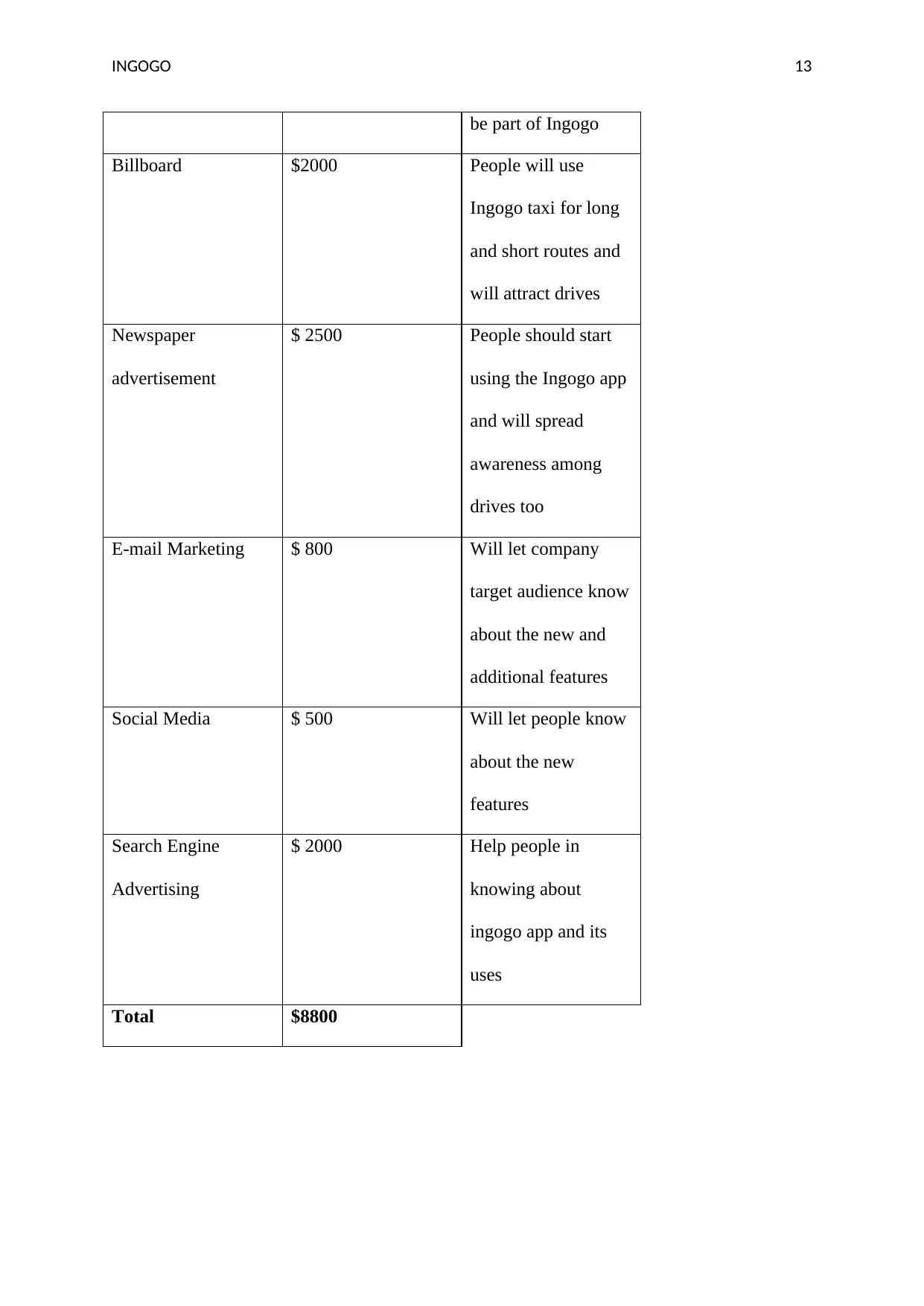
INGOGO 13
be part of Ingogo
Billboard $2000 People will use
Ingogo taxi for long
and short routes and
will attract drives
Newspaper
advertisement
$ 2500 People should start
using the Ingogo app
and will spread
awareness among
drives too
E-mail Marketing $ 800 Will let company
target audience know
about the new and
additional features
Social Media $ 500 Will let people know
about the new
features
Search Engine
Advertising
$ 2000 Help people in
knowing about
ingogo app and its
uses
Total $8800
be part of Ingogo
Billboard $2000 People will use
Ingogo taxi for long
and short routes and
will attract drives
Newspaper
advertisement
$ 2500 People should start
using the Ingogo app
and will spread
awareness among
drives too
E-mail Marketing $ 800 Will let company
target audience know
about the new and
additional features
Social Media $ 500 Will let people know
about the new
features
Search Engine
Advertising
$ 2000 Help people in
knowing about
ingogo app and its
uses
Total $8800
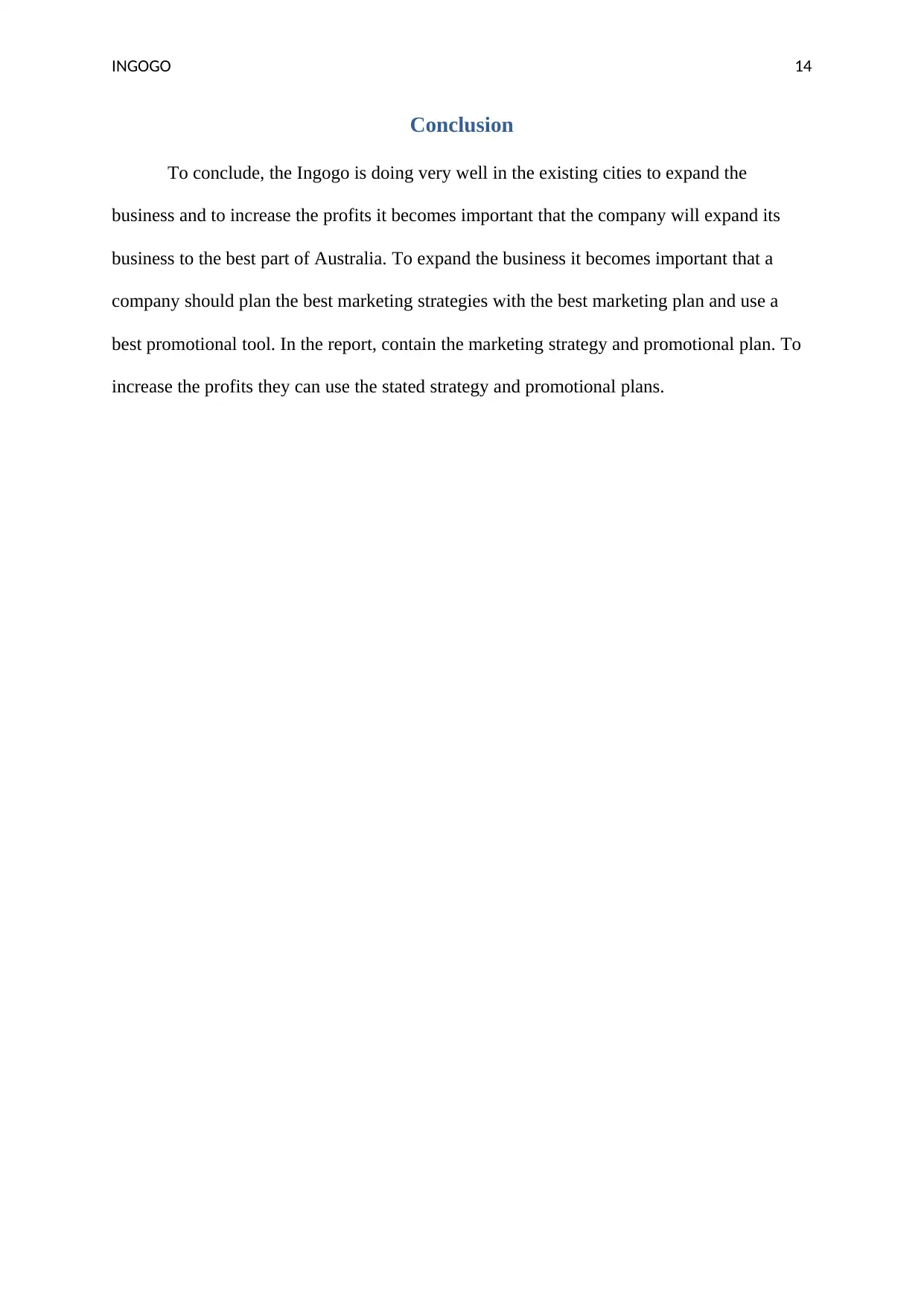
INGOGO 14
Conclusion
To conclude, the Ingogo is doing very well in the existing cities to expand the
business and to increase the profits it becomes important that the company will expand its
business to the best part of Australia. To expand the business it becomes important that a
company should plan the best marketing strategies with the best marketing plan and use a
best promotional tool. In the report, contain the marketing strategy and promotional plan. To
increase the profits they can use the stated strategy and promotional plans.
Conclusion
To conclude, the Ingogo is doing very well in the existing cities to expand the
business and to increase the profits it becomes important that the company will expand its
business to the best part of Australia. To expand the business it becomes important that a
company should plan the best marketing strategies with the best marketing plan and use a
best promotional tool. In the report, contain the marketing strategy and promotional plan. To
increase the profits they can use the stated strategy and promotional plans.
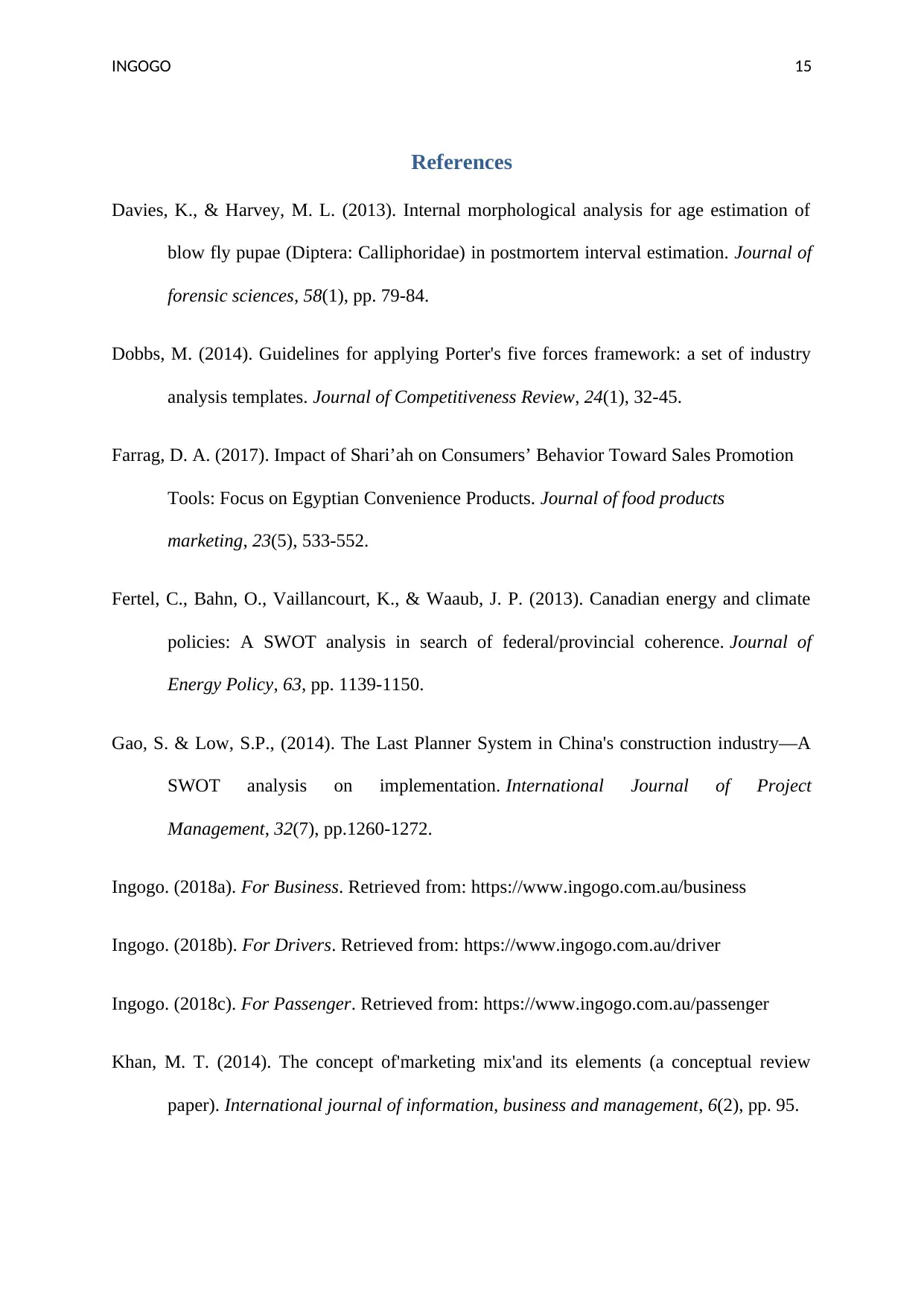
INGOGO 15
References
Davies, K., & Harvey, M. L. (2013). Internal morphological analysis for age estimation of
blow fly pupae (Diptera: Calliphoridae) in postmortem interval estimation. Journal of
forensic sciences, 58(1), pp. 79-84.
Dobbs, M. (2014). Guidelines for applying Porter's five forces framework: a set of industry
analysis templates. Journal of Competitiveness Review, 24(1), 32-45.
Farrag, D. A. (2017). Impact of Shari’ah on Consumers’ Behavior Toward Sales Promotion
Tools: Focus on Egyptian Convenience Products. Journal of food products
marketing, 23(5), 533-552.
Fertel, C., Bahn, O., Vaillancourt, K., & Waaub, J. P. (2013). Canadian energy and climate
policies: A SWOT analysis in search of federal/provincial coherence. Journal of
Energy Policy, 63, pp. 1139-1150.
Gao, S. & Low, S.P., (2014). The Last Planner System in China's construction industry—A
SWOT analysis on implementation. International Journal of Project
Management, 32(7), pp.1260-1272.
Ingogo. (2018a). For Business. Retrieved from: https://www.ingogo.com.au/business
Ingogo. (2018b). For Drivers. Retrieved from: https://www.ingogo.com.au/driver
Ingogo. (2018c). For Passenger. Retrieved from: https://www.ingogo.com.au/passenger
Khan, M. T. (2014). The concept of'marketing mix'and its elements (a conceptual review
paper). International journal of information, business and management, 6(2), pp. 95.
References
Davies, K., & Harvey, M. L. (2013). Internal morphological analysis for age estimation of
blow fly pupae (Diptera: Calliphoridae) in postmortem interval estimation. Journal of
forensic sciences, 58(1), pp. 79-84.
Dobbs, M. (2014). Guidelines for applying Porter's five forces framework: a set of industry
analysis templates. Journal of Competitiveness Review, 24(1), 32-45.
Farrag, D. A. (2017). Impact of Shari’ah on Consumers’ Behavior Toward Sales Promotion
Tools: Focus on Egyptian Convenience Products. Journal of food products
marketing, 23(5), 533-552.
Fertel, C., Bahn, O., Vaillancourt, K., & Waaub, J. P. (2013). Canadian energy and climate
policies: A SWOT analysis in search of federal/provincial coherence. Journal of
Energy Policy, 63, pp. 1139-1150.
Gao, S. & Low, S.P., (2014). The Last Planner System in China's construction industry—A
SWOT analysis on implementation. International Journal of Project
Management, 32(7), pp.1260-1272.
Ingogo. (2018a). For Business. Retrieved from: https://www.ingogo.com.au/business
Ingogo. (2018b). For Drivers. Retrieved from: https://www.ingogo.com.au/driver
Ingogo. (2018c). For Passenger. Retrieved from: https://www.ingogo.com.au/passenger
Khan, M. T. (2014). The concept of'marketing mix'and its elements (a conceptual review
paper). International journal of information, business and management, 6(2), pp. 95.
Secure Best Marks with AI Grader
Need help grading? Try our AI Grader for instant feedback on your assignments.

INGOGO 16
Leonidou, C. N., Katsikeas, C. S., & Morgan, N. A. (2015). “Greening” the marketing mix:
do firms do it and does it pay off?. Journal of the Academy of Marketing
Science, 41(2), pp. 151-170.
Pavelsky, T.M., Durand, M.T., Andreadis, K.M., Beighley, R.E., Paiva, R.C., Allen, G.H. &
Miller, Z.F., (2014). Assessing the potential global extent of SWOT river discharge
observations. Journal of Hydrology, 519, pp.1516-1525.
Pike, S., & Page, S. J. (2014). Destination Marketing Organizations and destination
marketing: A narrative analysis of the literature. Journal of Tourism management, 41,
pp. 202-227.
Prassl, J., & Risak, M. (2015). Uber, Taskrabbit, and Co.: Platforms as Employers-
Rethinking the Legal Analysis of Crowdwork. Journal of Comp. Lab. L. & Pol'y
J., 37, pp. 619.
Pyo, S. (2015). Integrating tourist market segmentation, targeting, and positioning using
association rules. Journal of Information Technology & Tourism, 15(3), pp. 253-281.
Sohel, S. M., Rahman, A. M. A., & Uddin, M. A. (2014). Competitive profile matrix (CPM)
as a competitors’ analysis tool: A theoretical perspective. International Journal of
Human Potential Development, 3(1), pp. 40-47.
Sohel, S. M., Rahman, A. M. A., & Uddin, M. A. (2014). Competitive profile matrix (CPM)
as a competitors’ analysis tool: A theoretical perspective. International Journal of
Human Potential Development, 3(1), pp. 40-47.
Tiago, M., & Veríssimo, J. M. C. (2014). Digital marketing and social media: Why
bother?. Journal of Business Horizons, 57(6), pp. 703-708.
Leonidou, C. N., Katsikeas, C. S., & Morgan, N. A. (2015). “Greening” the marketing mix:
do firms do it and does it pay off?. Journal of the Academy of Marketing
Science, 41(2), pp. 151-170.
Pavelsky, T.M., Durand, M.T., Andreadis, K.M., Beighley, R.E., Paiva, R.C., Allen, G.H. &
Miller, Z.F., (2014). Assessing the potential global extent of SWOT river discharge
observations. Journal of Hydrology, 519, pp.1516-1525.
Pike, S., & Page, S. J. (2014). Destination Marketing Organizations and destination
marketing: A narrative analysis of the literature. Journal of Tourism management, 41,
pp. 202-227.
Prassl, J., & Risak, M. (2015). Uber, Taskrabbit, and Co.: Platforms as Employers-
Rethinking the Legal Analysis of Crowdwork. Journal of Comp. Lab. L. & Pol'y
J., 37, pp. 619.
Pyo, S. (2015). Integrating tourist market segmentation, targeting, and positioning using
association rules. Journal of Information Technology & Tourism, 15(3), pp. 253-281.
Sohel, S. M., Rahman, A. M. A., & Uddin, M. A. (2014). Competitive profile matrix (CPM)
as a competitors’ analysis tool: A theoretical perspective. International Journal of
Human Potential Development, 3(1), pp. 40-47.
Sohel, S. M., Rahman, A. M. A., & Uddin, M. A. (2014). Competitive profile matrix (CPM)
as a competitors’ analysis tool: A theoretical perspective. International Journal of
Human Potential Development, 3(1), pp. 40-47.
Tiago, M., & Veríssimo, J. M. C. (2014). Digital marketing and social media: Why
bother?. Journal of Business Horizons, 57(6), pp. 703-708.
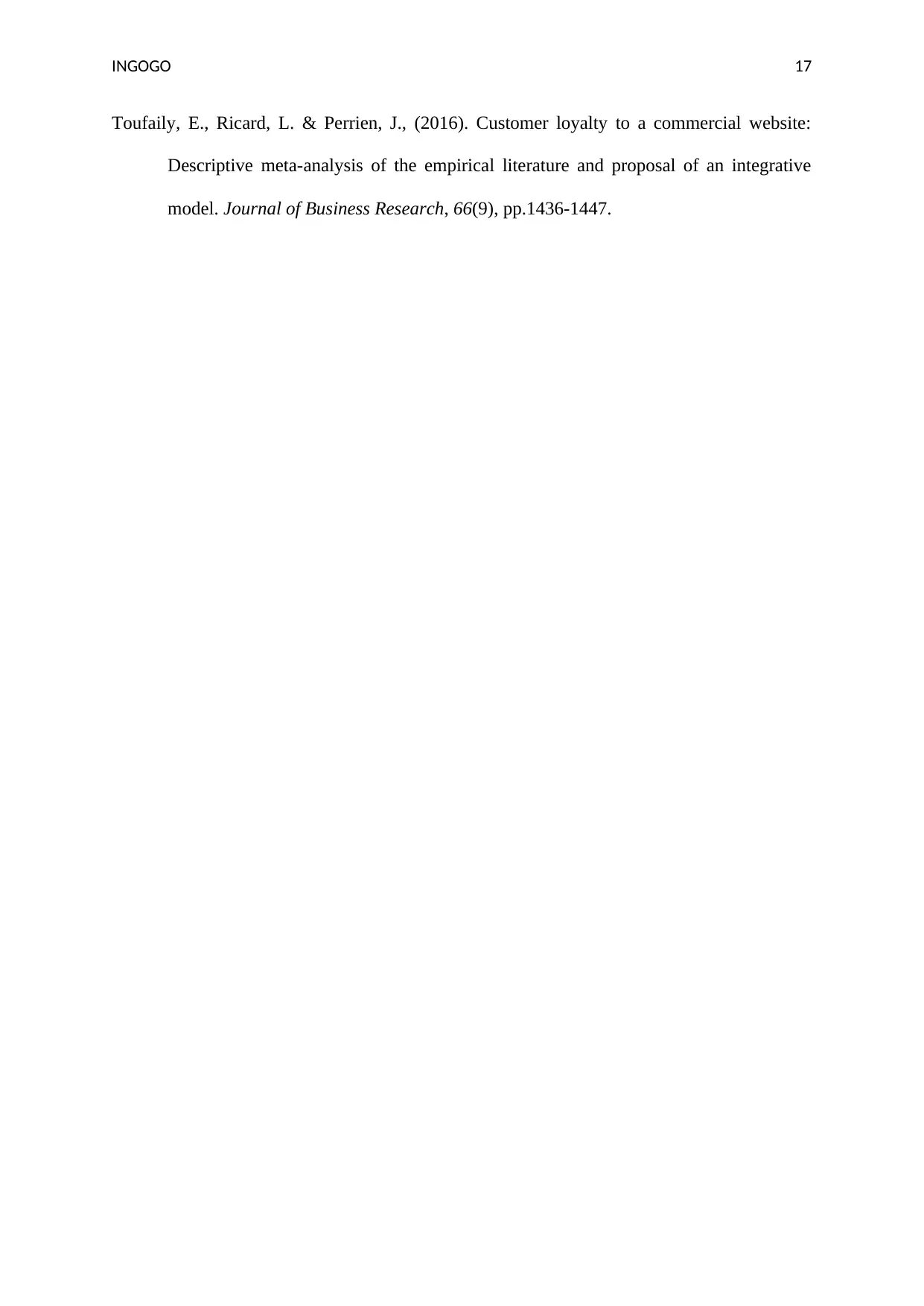
INGOGO 17
Toufaily, E., Ricard, L. & Perrien, J., (2016). Customer loyalty to a commercial website:
Descriptive meta-analysis of the empirical literature and proposal of an integrative
model. Journal of Business Research, 66(9), pp.1436-1447.
Toufaily, E., Ricard, L. & Perrien, J., (2016). Customer loyalty to a commercial website:
Descriptive meta-analysis of the empirical literature and proposal of an integrative
model. Journal of Business Research, 66(9), pp.1436-1447.
1 out of 18
Related Documents
Your All-in-One AI-Powered Toolkit for Academic Success.
+13062052269
info@desklib.com
Available 24*7 on WhatsApp / Email
![[object Object]](/_next/static/media/star-bottom.7253800d.svg)
Unlock your academic potential
© 2024 | Zucol Services PVT LTD | All rights reserved.





